There is something about the American West that calls to us. My inner compass always pulls me westward. For me, going West means exploring wild, untameable lands ripe with history and authenticity. But where does the West begin? If you’re in Texas, the edge of the West can be found at San Angelo State Park.
In this guide, you’ll find everything you need to plan your visit to San Angelo State Park (SASP), including:
- What makes SASP unique and worthwhile to visit.
- Where to stay, what to do and see.
- Tips, activities, and about the Junior Ranger program.
If you’re looking to get a taste of western adventure, San Angelo State Park is LITERALLY on the starting line. Read on to plan your visit!
Why SASP? It’s an Ecological Crossroads
Okay, but really, where is the edge of the West. Well…it depends on who you ask. For example, the U.S. Census Bureau considers the West to be a set of 13 states from New Mexico to California. While the city of Fort Worth, TX claims it’s “Where the West begins”. But wildness and vastness knows no borders. The West is really about landscape and history. That’s why the Bill Lane Center for the American West denotes the 100th meridian as the edge of the West. Basically, anything from 100°W longitude westward defines the American West.
It so happens that SASP sits at about 100.5° W longitude. That’s right, it’s actually on the edge of the American West.
SASP flanks the western outskirts of the city of San Angelo, Texas. And keeping to the theme that everything is bigger in Texas, the park spans over 7,600 acres! Within this immense space you’ll find rolling prairies, mesquite woodlands, desert brushlands, and the serene waters of the O.C. Fisher Reservoir. Basically, a veritable ecological crossroads that is a haven for wildlife and adventure seekers alike.
A Little Science!
SASP is unique because it encompasses an area where different ecoregions converge. Within the park boundaries there are areas from the High Plains, Rolling Plains, the Edwards Plateau, and Trans Pecos ecological regions. It is an ecological transition zone. Also known as an ecotone, these areas are defined as places where two or more distinct ecosystems meet and integrate. These zones often exhibit characteristics of both neighboring ecosystems and can host unique combinations of species and environmental conditions.
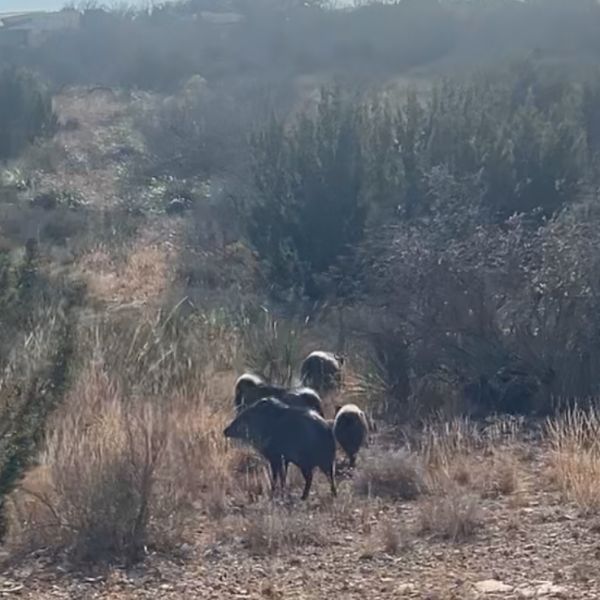
Key features of an ecological transition zone that are on display at SASP include:
Dynamic Interactions: The interactions between species and environmental factors in transition zones can lead to dynamic processes, including competition, migration, and adaptation.
High Biodiversity: Ecotones tend to support a wide variety of species, as they often include species from each adjacent ecosystem as well as species specifically adapted to the transitional conditions.
Environmental Gradients: These zones are marked by gradual changes in environmental factors, such as soil type, moisture, temperature, or light availability.
All of this to say that SASP offers visitors a unique blend of natural beauty, history, and outdoor recreation. You can explore miles of hiking and biking trails, shore and boat fishing, or trek to see ancient fossilized tracks from prehistoric creatures. The park invites exploration and reflection. Whether you’re looking to camp under a star-filled sky, enjoy a peaceful picnic, or discover the region’s rich ecological and cultural heritage, San Angelo State Park promises an unforgettable experience for nature enthusiasts of all ages.
How to Get There: Visiting the Edge of the American West
One of the interesting things about San Angelo, TX is that you pretty much have to be going there to get there. This small city of ~100,000 people is situated 90 miles south of Interstate 20 and 90 miles north of Interstate 10. Although out of the way, San Angelo boasts a robust downtown with restaurants, breweries, and boutiques. Other unique sites to see include the Fort Concho National Historic Site, the International Water Lily Collection, or the San Angelo River Walk.
If you have visited a Texas State Park before-Yay! And you might already know that the best place to start planning your visit to SASP is by using the Texas State Park app. This app has the details on each unit in the Texas State Park system and links you to the park reservation system. Use the online reservation system to purchase day passes, reserve campsites, group sites, and download maps and other information about the park.
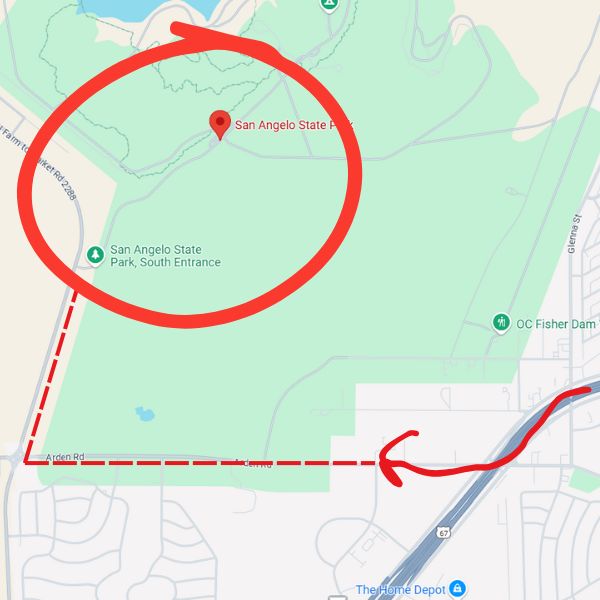
After you have soaked in some west Texas culture in the city of San Angelo, take Loop 306/Hwy 67 to Arden Rd and follow the signs to SASP. This will take you to the South Entrance of the park. I recommend entering here so you can stop by park headquarters to get oriented. Also, if you have not purchased day passes or camping reservations you must obtain those at park headquarters. Typically, the North Entrance is not fully staffed and visitors with day passes or reservations to a North Concho Unit campground are given a code to unlock the gate.
Stay Awhile: Lots of Camping to Choose From
Due to its size, SASP has upwards of 100 camping sites to choose from depending on what you would like to do and see in the park. SASP is divided into a North Concho Unit and a South Concho Unit. Both units have numerous multiuse trails open to everyone, but as discussed above the ecotones offer different experiences. Campsites with electricity will cost $20 per night, group sites are $50 per night, and primitive campers will only pay $10 per night.
North Concho Unit Camping
The North Concho Unit predominantly features the North Concho river prior to its entrance into O.C. Fisher reservoir. There are 3 main camping areas in this unit. The North Concho Camping Area offers equestrian sites with electricity, picnic tables, outdoor grills, and restrooms with showers nearby. Equestrian sites are equipped with pens and areas to safely tie horses while at camp. The Bald Eagle Camping Area also has electricity, picnic tables, and outdoor grills, but no pens. However, horses are allowed in this camping area if the North Concho Camping Area is full. For a more primitive experience, take a short trek to the River Bend Camping Area. These sites are for tent camping only and have water and a composting toilet nearby.
South Concho Unit Camping
If you want to visit the hub of the park, the South Concho Unit is closer to the longhorn viewing area, park headquarters, and lake access. On this side of the park you can stay at the Red Arroyo Camping Area which has 40 sites with electricity, water hookup, picnic tables, outdoor grills, and fire rings. There are also restrooms with showers nearby. If you are visiting with a large group, the Chaparral Group Area accommodates up to 8 people per site with electricity and water hookups. Group campers also have access to the Chaparral Pavilion nearby. For something a little more centrally located, that is somewhat in between the North and South Units, stay at the Isabel Harte Multi-Use Area. These sites do not have electricity, but there are picnic tables, shaded areas, and water and restrooms nearby.
Hit the Trail: Miles and Miles of Trails
SASP is a large park, even by Texas standards, and this means there are miles and miles of trails. In fact, there are 50 miles of multiuse trails for hiking, biking, and horseback riding! SASP is a hugely popular place for mountain bikers because of its varied terrain and length of trails. There are trails for all hiking abilities and don’t forget your pets!
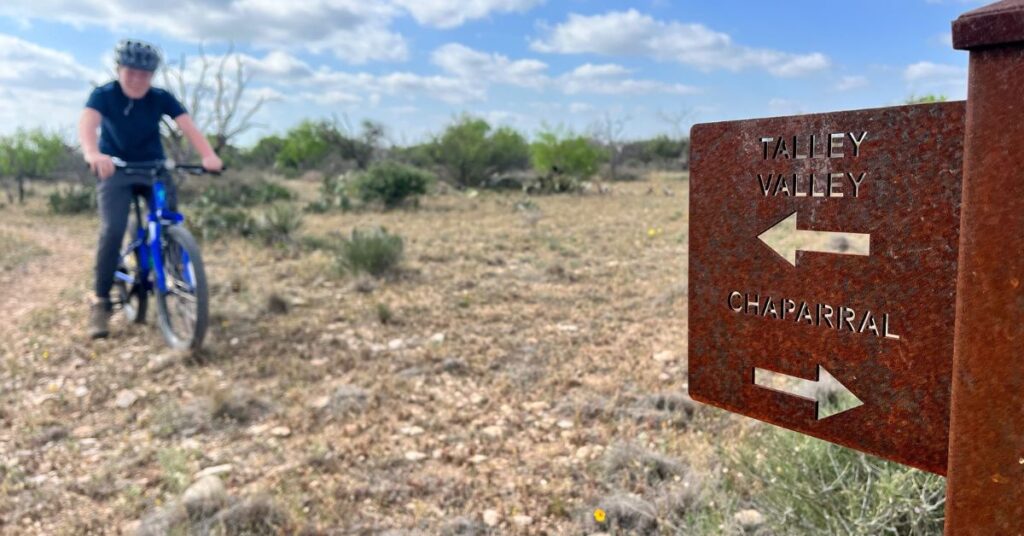
One of my favorite hikes starts at the Burkett Trailhead, Burkett trail takes you west along Potts Creek where you connect with an old service road to join the Roller Coaster trail. This trail is moderate to difficult with some elevation gain through rocky terrain. Or you can stroll along the Roadrunner Trail for more level terrain typical of a mesquite shrubland. Each trail gives you a different experience of a land where different ecosystems collide. Be prepared to make new observations in your Guided Field Journal and jot down your hike in the Trail Log 🙂
Quintessentially Texan: The Official Texas State Longhorn Herd
What do you think of when you think of Texas? Cowboy boots? The Lone Star? Or maybe longhorn cattle! The Official Texas State Longhorn Herd is maintained as a testament to the rich cultural and historical heritage of Texas. The state herd originated from Spanish cattle brought to Texas in the late 17th century.
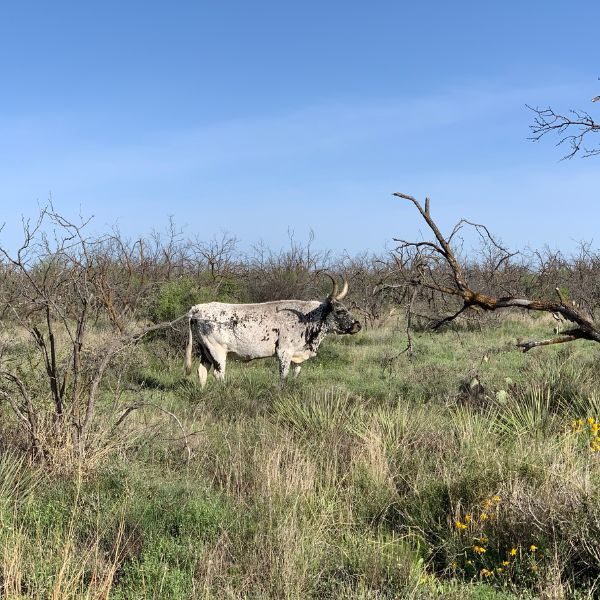
These resilient animals embody the spirit of the West. You can easily recognize them by their iconic long, curved horns that can span up to 7 feet! The herd is managed by the Texas Parks and Wildlife Department. They roam across several state parks and historic sites, including San Angelo State Park. SASP offers visitors a chance to get up close and personal with the longhorns during regular ranger-led programs. More than just a symbol of Texas pride, the herd plays a crucial role in preserving the genetic lineage of this historic breed.
Be in the Know: More than Hiking and Biking
Because of its proximity to San Angelo, SASP hosts regular events to get locals and visitors out and about in the park. Park Rangers lead interpretive programs for all ages and abilities. From nature walks to longhorn and bison viewing tours, there is something for everyone.
Star Gazing
You know you’ve reached the West when the night sky reaches as far as the eye can see and becomes a part of the landscape. Although not a designated dark park, SASP offers a serene haven for star-gazing enthusiasts. Just outside the reach of the intrusive glow of city lights, the park provides an expansive night sky, perfect for marveling at constellations, planets, and meteor showers. The wide-open spaces and elevated viewpoints, such as along the Isabel Harte area trails, create an ideal setting to lay out a blanket and lose yourself in the vastness of the universe. On especially clear nights, the Milky Way stretches brilliantly across the horizon, making it an unforgettable experience for both seasoned astronomers and casual sky watchers.
Geocaching
Are you looking to add a little game to your hike? Try geocaching! Texas State Parks are great places for geocaching! SASP has loads of geocaches hidden all throughout the park. Simply choose a cache to find and you’ll be exploring points of interest within the park. Geocaching is a fun way to navigate to different areas with the added thrill of finding a hidden cache left by a fellow traveler. If you want to learn more about geocaching, read Join the Hunt! Start Geocaching to begin your adventures!
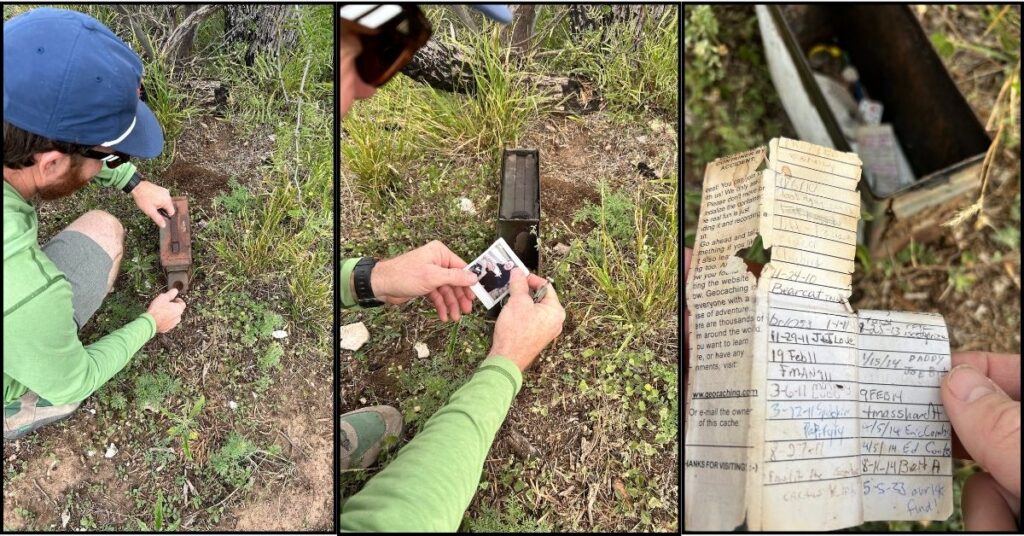
Texas State Parks Junior Ranger Program
If you are visiting SASP with children, consider getting them started with the Texas State Parks Junior Ranger Program. Texas State Parks began the Junior Ranger program because kids who spend time outdoors in nature are happier and healthier! The Junior Ranger Program encourages kids, generally 6 to 12 years of age, to visit state parks and learn about the landscapes, wildlife, and history.
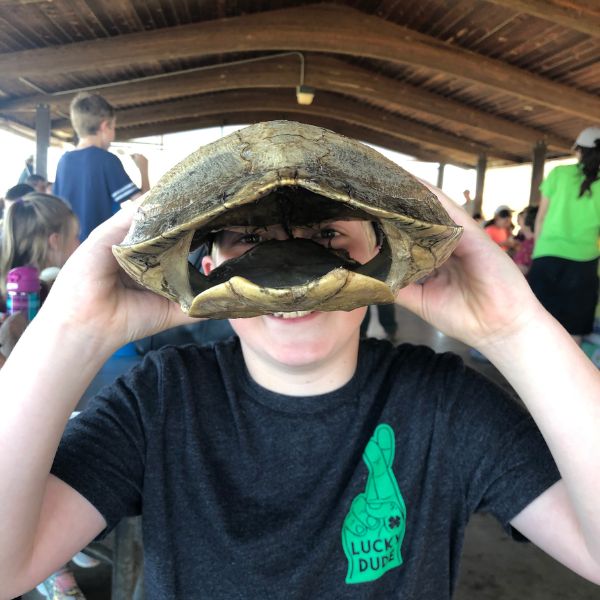
SASP holds kid-friendly interpretive events, including Arts in the Park and Star-Gazing, to help aspiring Junior Rangers complete their journal activities to earn their badges. Junior Rangers learn about outdoor safety, the principles of Leave No Trace, and the importance of conservation of wild places. It’s outdoor fun for the whole family!
Head West: Beginning at San Angelo State Park
SASP sits on the edge of the wild West. This land is a unique blend of 4 ecosystems creating a biodiverse rich landscape. The park’s many campgrounds and accessibility to the city of San Angelo make it a great place for a quick escape. Enjoy miles of multiuse trails, dark skies perfect for stargazing, or the thrill of geocaching. There really is something for everyone to Embark, Explore, and Enjoy!
Discover more from Tenderfoot Hiking
Subscribe to get the latest posts sent to your email.


Great information about San Angelo State Park!
Thank you! I see something different every time we go out there. Close to town, but feels wild 🙂